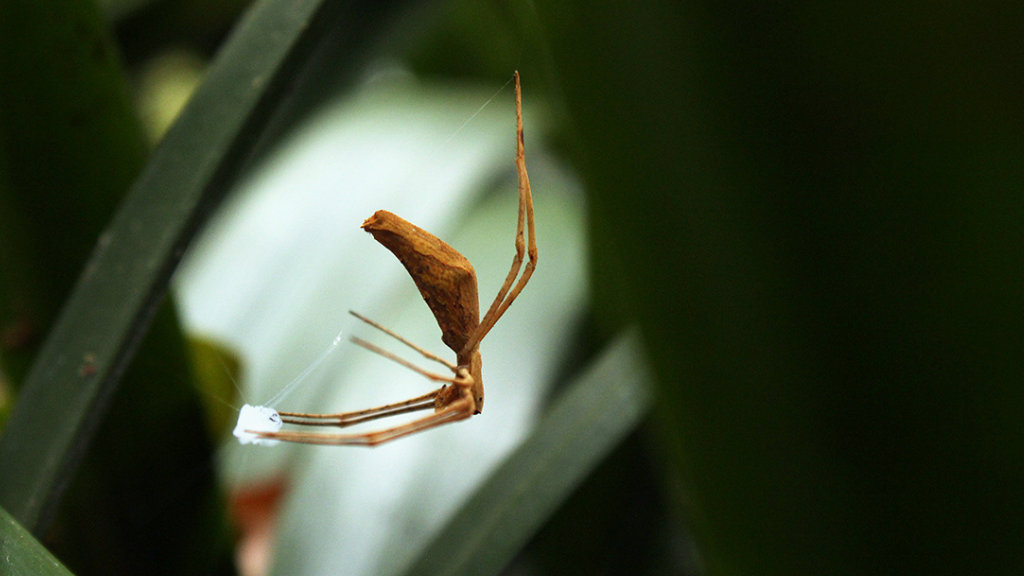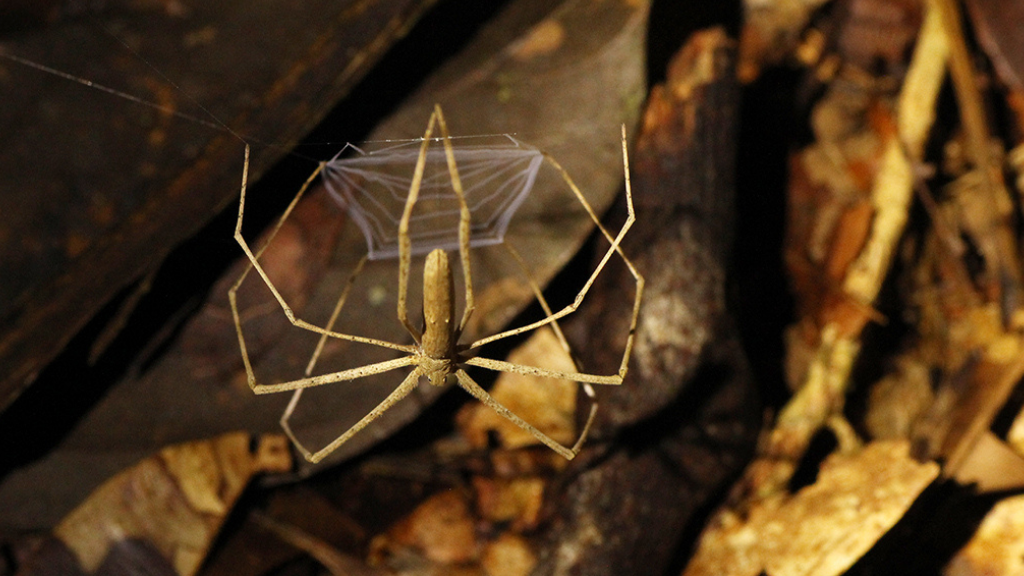Look Ma, no ears! Teensy spiders hear with organ on their legs

Ogre-faced spiders hang from their webs, and like gymnasts, they flip backwards to snatch flying insects from the air. To hear their prey coming, the spiders "listen" for the flap of tiny wings using a special organ in their spindly legs, a new study has found.
The organ looks like a patch of parallel slits cut into the spider's exoskeleton; located near the tip of each leg, each slit measures between 0.0000003 and 0.000007 inches (10-200 nanometers) in length. These tiny slits contain nerve cells that detect minute changes in pressure caused by sound waves rippling through the air; the organ then sends this information to the brain.
Thus equipped, ogre-faced spiders (Deinopis spinosa) can hear sounds up to 6.5 feet (2 meters) away and pick up frequencies between 100 and 10,000 hertz, according to a new study, published Oct. 29 in the journal Current Biology. Humans can hear sounds between about 20 and 20,000 hertz, for context.
"It's very alien to us because we don't have a sensory system like this," said study author Jay Stafstrom, a postdoctoral researcher studying sensory biology at Cornell University.
Humans, of course, use their eardrums to detect sounds, but spiders don't have eardrums. That said, Stafstrom and his colleagues suspected that the ogre-faced spider might rely on some form of hearing to snag flying prey from the air — and the new study supports that suspicion.
Related: 21 totally sweet spider superlatives
The authors found that certain sounds sent the spiders flipping; as if on cue, the arachnids would hear the sound and perform a sudden half-backflip as if launching toward a passing bug. Ogre-faced spiders can be found in forested regions of Australia, Africa and parts of the United States, including Florida, according to Cosmos Magazine; the teeny spiders, which measure less than an inch (1.5-2.5 cm) in length, hide among palm fronds and other vegetation and use their nimble acrobatics to catch moths, mosquitoes and flies that fly past.
Sign up for the Live Science daily newsletter now
Get the world’s most fascinating discoveries delivered straight to your inbox.
The flip is "ballistically rapid, it's very quick … and they're surprisingly accurate," in terms of enabling the spider to catch prey on the fly, Stafstrom told Live Science. "From such a tiny little spider, with a tiny little brain, it's very impressive."
In general, ogre-faced spiders are better known for their impressive vision than their hearing. "They've got the biggest eyes of any spider," Stafstrom said. The spiders hide from predators throughout the day, camouflaged to blend in with the plants they live on. At night, the arachnids emerge and use their two huge, night-vision eyes to spot crawling insects on the ground below. To catch the creepy-crawlies, the spiders hang suspended from a web near the ground and ensnare bugs in a tiny, stretchable net that they hold between four legs.
The spiders deploy the same net to catch flying insects, but they contort their bodies backwards to aim the net upward, rather than lurching down toward the ground. It wasn't initially clear, however, if the spiders relied on their night-vision to aim the net at flying prey.

In a previous study, published 2016 in the journal Biology Letters, Stafstrom set out to determine whether ogre-faced spiders even needed their eyes to capture flying insects. He blindfolded the spiders using dental silicone, a kind of opaque plastic, and found that they could no longer capture crawling prey from the ground, but they could still pluck flying insects right out of the air. Clearly, they were relying on some other sense besides vision, Stafstrom said.
In the new study, Stafstrom and his co-authors played different sounds for the spiders to see if any would trigger their signature backflip. When exposed to low-frequency sounds, between 150 Hz and 750 Hz, the spiders lurched backwards and stretched their nets as if to catch a bug. These low-frequency sounds mimic the wingbeat patterns of various flying insects, the authors noted. The authors found that no sounds of any frequency caused the spiders to aim forward toward the ground, confirming that the spiders use their vision, not hearing, to catch crawling prey.
Related: Creepy, crawly and incredible: Photos of spiders
Compared with low-frequency sounds, high-frequency tones did not send the spiders somersaulting. However, electrical recordings of the spiders' brain cells revealed that specific groups of brain cells, or neurons, react to high frequencies, specifically between 1,000 Hz and 10,000 Hz; the sensory organ in the spiders' legs reacted to the same range of sounds. The authors speculate that, since flying insects don't flap their wings at such high rates, the spiders might also listen for the high-pitched call of predator birds.
"It might be an early warning sign, that a bird that could end your life may be in the vicinity," Stafstrom said. "We're really interested in knowing, 'Can these spiders hear bats?'" he added, but the study didn't include frequencies high enough to mimic most bat chirps.
While the study of spider hearing remains quite new, several other arachnid species can also hear sound, Stafstrom noted.
For instance, jumping spiders sense and respond to sounds more than 9.8 feet (3 m) away, Live Science previously reported. Jumping spiders have pressure-sensitive leg hairs that respond to the movement of air particles around them. Ogre-faced spiders also have these special leg hairs, and jumping spiders have the same sensory organ in their legs as the ogre-faced does.
"We suspect that both spiders are using both systems," but that has yet to be confirmed, Stafstrom said.
With the discovery that ogre-faced spiders use their hearing to capture prey, Stafstrom and his team now wonder how well the spiders can discern which direction a given sound is coming from. They plan to place the spiders in an arena and play sounds from various angles, to see whether the spiders change up their acrobatic routine to aim their net in the corresponding direction.
Originally published on Live Science.

Nicoletta Lanese is the health channel editor at Live Science and was previously a news editor and staff writer at the site. She holds a graduate certificate in science communication from UC Santa Cruz and degrees in neuroscience and dance from the University of Florida. Her work has appeared in The Scientist, Science News, the Mercury News, Mongabay and Stanford Medicine Magazine, among other outlets. Based in NYC, she also remains heavily involved in dance and performs in local choreographers' work.










